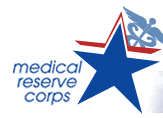
|

|
|
|
 Home > About the Medical Reserve Corps > OCVMRC Strategic Plan 2009–2010On this page:
About the Strategic PlanThis strategic plan represents the direction of the Office of Civilian Volunteer Medical Reserve Corps (OCVMRC) for the years 2009–2010. This plan aligns OCVMRC with the plans and priorities of the Office of the Surgeon General (OSG), the Office of Public Health and Science (OPHS), and the Office of the Assistant Secretary for Preparedness and Response (ASPR), as well as the Department of Health and Human Services (HHS). What is the MRC?The Medical Reserve Corps (MRC) is a national network of local groups of volunteers committed to improving the health, safety and resiliency of their communities. MRC volunteers include medical and public health professionals, as well as others interested in strengthening the public health infrastructure and improving the preparedness and response capabilities of their local jurisdiction. MRC units identify, screen, train and organize the volunteers, and utilize them to support routine public health activities and augment preparedness and response efforts. What is the OCVMRC?The Office of the Civilian Volunteer Medical Reserve Corps is headquartered in the OSG. It functions as a clearinghouse for information and guidance to help communities establish, implement, and maintain MRC units nationwide. Office activities include strategic planning, intra- and interagency coordination, communications, policy development, program operations, grants management, contract oversight, technical assistance, and deployment operations. These activities are carried out by OCVMRC staff and the MRC Regional Coordinators. Who is this strategic plan designed for?This strategic plan is designed for the OCVMRC (not the MRC network). Focusing on issues that we can directly affect and control, and directing the implementation of this strategic plan towards those issues, will ultimately lead to improvement in the overall MRC network and accomplishment of the MRC mission. How will this strategic plan be used?In order to accomplish our collective missions and achieve our vision, we have initiated this strategic planning process to allow us to meet today’s issues and tomorrow’s challenges. This Strategic Plan outlines our priorities. Flexibility is built into the plan with the understanding that we will need to respond to Departmental requests and directives, as well as to emerging issues that affect MRC units. We see this as a living document that will be reviewed continually by OCVMRC staff. We commit to:
Contents of the Strategic Plan
Download a printer-friendly version of the OCVMRC Strategic Plan 2009–2010 (Adobe PDF [41.2 KB]). OCVMRC Strategy MapDownload the OCVMRC Strategy Map (Adobe PDF [29.0 KB]). Last Updated on 4/14/2009 |



